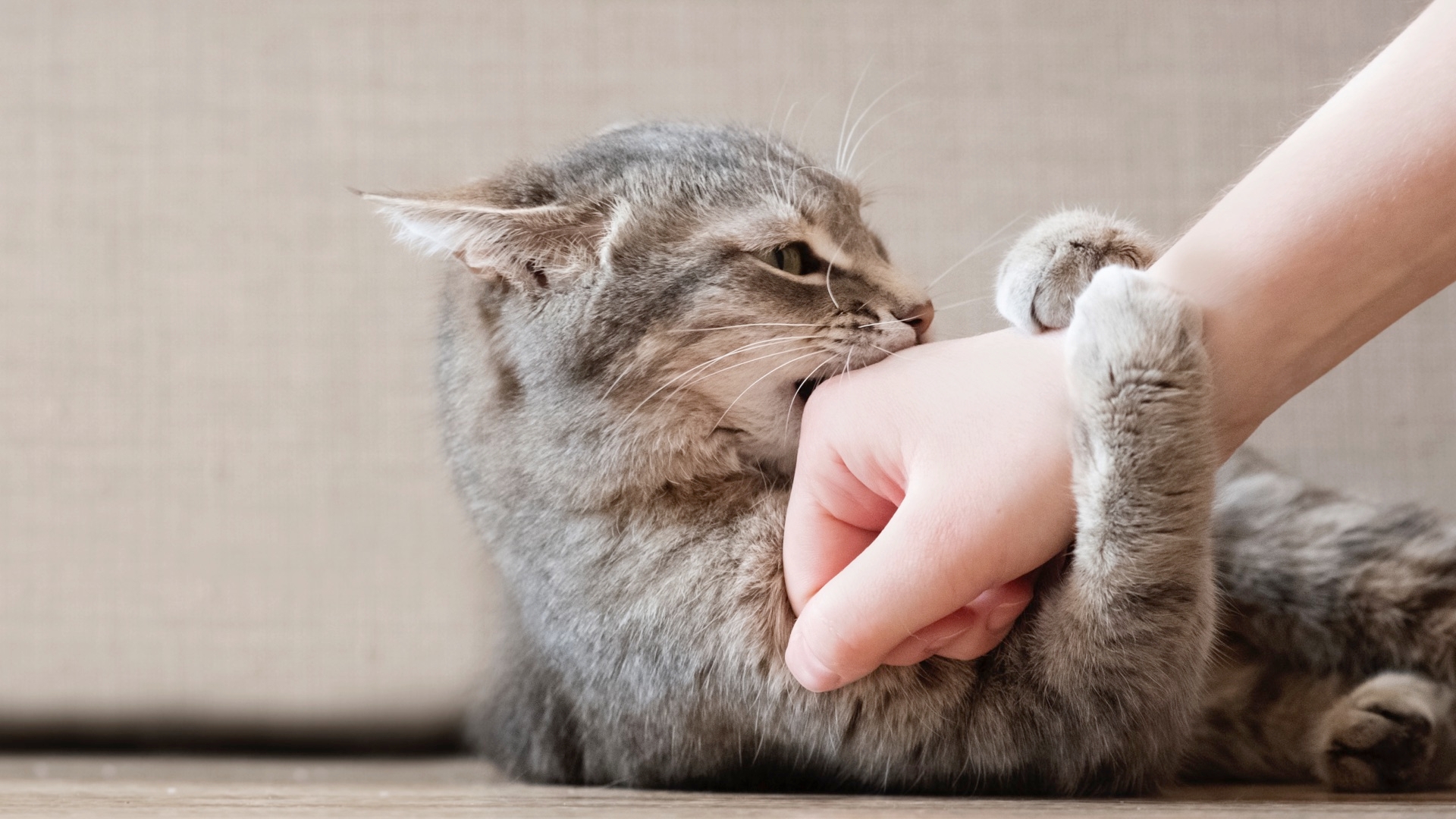Cat Aggression:
Summary:
The well-fed house cat is an unmotivated and clumsy hunter. However, your cat still has the skills and instincts of a born predator. This shows up as play – stalking, pouncing, chasing anything that moves, and ambushing you or other companion animals are all feline ways of having a good time.


Aggression in Cats
Is it really "aggression?"
If your cat lunges at your ankles when you walk by, it might be aggression. But, more likely, it's play.
The well-fed house cat is an unmotivated and clumsy hunter. However, your cat still has the skills and instincts of a born predator. This shows up as play – stalking, pouncing, chasing anything that moves, and ambushing you or other companion animals are all feline ways of having a good time.
However, the effect of playful "aggression" can be just as damaging and painful as the real thing! Shape your cat's play to appropriate toys or another cat.
Solo cats get pretty bored during the day and are often more likely to play rough with you (or your furniture, drapes, etc). A second cat is often the cure. When that is not an option, routine long play sessions with interactive toys are crucial.
Finally, be sure your not sending a mixed message. If you use your bare hands to play with a kitten, don't be surprised if that cat chomps and scratches you happily as an adult. After all, you taught Kitty that human flesh is an appropriate toy! Even if you don't mind some scratches and nips, your friends and family probably will – it's better to make human flesh "off-limits" for your cat's teeth and nails.
Fearful Aggression
Any cat will fight being restrained. Any injured or frightened animal will bite or scratch.
Any animal startled out of a sound sleep may attack the first thing to come into view. Most animals become possessive of food, toys, sleeping spaces, and other resources and may defend them aggressively.
Cats also are notoriously poor at adjusting to change. We know of cats who became irritable and went off their food after something as simple as rearranging the furniture! The point is, any change can make your cat jumpy and more likely to bite or scratch.
Even though they have the instincts of predators, cats don't go looking for trouble. If startled, they generally make a hasty retreat. However, if a cat is confronted with a sudden danger and it's too late to escape, that cat may attack with or without warning.
Real Aggression
For no particular reason, your cat just up and bites you. Was it a play nip? Was it for attention? Did you startle the cat? Could something else have startled the cat (including sounds that may be beyond your range of hearing)?
The demeanor of the cat at the time of the bite is important, too. Was the tail lashing? Ears laid back? Did the cat growl, snarl, or hiss first? Did the cat give you a "hard stare?" These could indicate a genuinely aggressive bite.
"Real" aggression often has a physical basis. Your cat should be thoroughly examined by a veterinarian, possibly including a blood chemistry screen. Kidney, liver, urinary tract, or other problems may be the reason for your cat's unpredictable behavior. Watch for other neurological signs such as sudden clumsiness in walking, twitches, head tilts, and noticeable differences in the size of the cat's pupils.
Safety First
Wash cat bites and scratches thoroughly with hot water and soap (preferably a disinfectant soap or Betadine surgical scrub). Keep cat bite wounds open so they heal from the bottom up- they get infected easily. It's advisable to get medical attention for cat bites. Of course, we believe the best place for your housecat is your house. However, if your cat does go outside, bites or scratches carry a risk of rabies. Your cat should be seen by your veterinarian within 24 hours after biting, kept indoors for the next 10 days, and examined again on the tenth day. In many areas, this is the law.
Aggression between Cats
Are you sure it's aggression?
Most cats like to rough-house. They chase each other, pounce, bite, wrestle, and tumble across the floor. There may be some vocalizing.
Unless one or both cats are screaming and snarling loudly, you're probably witnessing play. The cat's facial expressions are a tip off too.
Introducing a new cat
Expect some hissing and swatting. Give a new arrival his or her own room for at least a few days. This allows the resident cat(s) to hear and smell the newcomer without having the challenge of meeting face to face. Introduce the new cat slowly, and only under supervision. Be certain to reassure the resident cat(s) as much as possible. Eventually, things will settle down. Usually the "worst case scenario" is that the cats appear to more or less ignore one another. The initial adjustment period can be anywhere from a day or two to three months or more, so you'll need patience.
Cats that used to get along
If you already live in a multiple cat household, you may have had this happen to you- two cats that used to tolerate each other suddenly hiss and yowl almost constantly.
If the problem persists for a few days without any sign of improvement, the next step is a trip to the veterinarian. There are many types of health problems that can make a cat more irritable. Illness can also subtly alter the cat's behavior and scent something we miss, but that bothers another cat.
Assuming everything checks out okay at the veterinarian's office, take a close look at your household. Have there been any changes? Cats don't take change very well. A different schedule, the addition or absence of a family member, different food, even redecorating can be enough to put a Tabby on the defensive. If there's no clear explanation for the sudden aggression, you may have to reintroduce the cats. Wipe both cats down with a wash cloth and distilled water, then follow the steps for introducing a new cat.
Fighters and Biters
A truly aggressive cat is rare. Some cats are quick on the defensive and will scratch and/or bite without warning if provoked even a little.
The overwhelming majority of these incidents are misunderstandings – the cat does not want to be touched; the cat does not want to be picked up; the cat was startled by a sudden movement or sound.
An unneutered male cat will fight with other cats and be more aggressive towards humans. Neutering and spaying are an absolute requirement to control any aggressive behavior.
If your cat continues to show genuine aggression toward other cats, you probably have a "one-cat household" cat. However, schedule a visit to the vet to make sure there's no physical problem.
The Alpha Female Cat
Among spayed and neutered cats there are some females that are dominant by nature- these are the alpha females. In a multiple cat household, there is often a female at the top of the cat hierarchy. This cat has a lot of responsibility- it is her job to keep all of the other cats in line. She can't seem to find much time to play because of this responsibility. She can't change this; it is just her personality. An alpha female must keep her place at the top of the hierarchy at all times. Sometimes it is necessary for her to howl, yell and hiss at one of the other resident cats for no apparent reason, just to let them know who's boss. Often the other cats will need to be whacked on the head a few times to remind them who is in charge of the cat family. It is very important that she should get the first plate for food at eating time, as top cat she is entitled to eat first. Alpha female cats are happiest as the only cat in a household, or where other resident cats have mellow personalities. The majority are best suited to live with mellow male cats. Alpha females are also more likely to get over stimulated when petted.
So let the alpha female cat just be herself, after all she is in charge of everything and that is a big responsibility.


